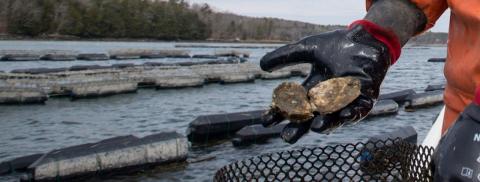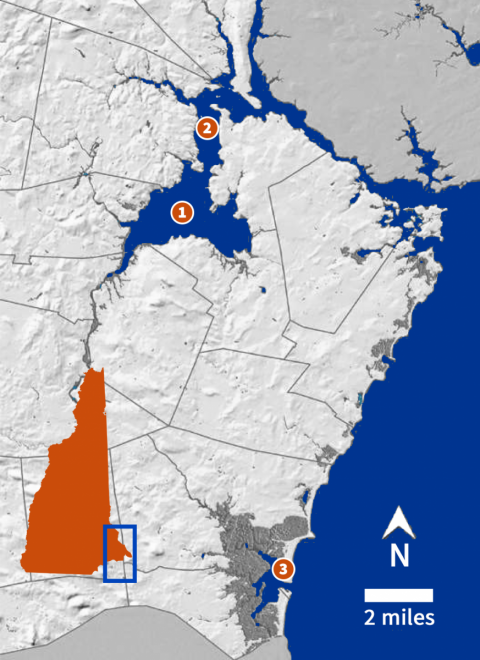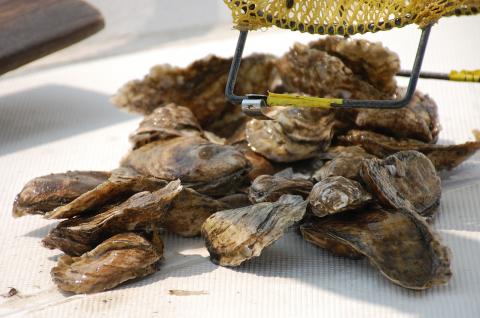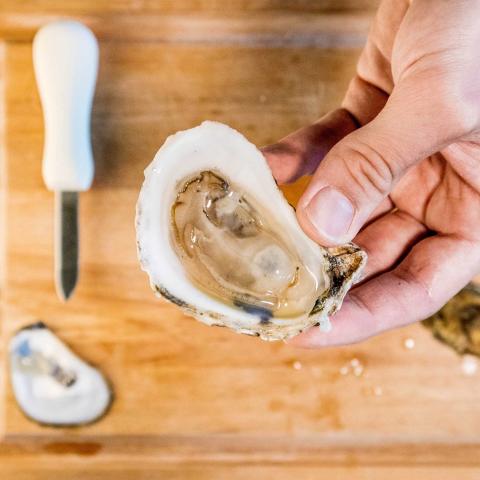
The ebb and flow of New Hampshire’s two estuaries, the Great Bay Estuary and Hampton-Seabrook Estuary, drive unique and diverse ecosystems that support the Granite State’s tradition of oyster aquaculture.
Oyster aquaculture, carefully managed by the NH Fish and Game Department, is currently the fastest growing seafood industry in New Hampshire.

In recent years, the growth and expansion of oyster farming has helped to keep New Hampshire’s rich maritime culture alive as an alternative to wild-harvest marine fisheries, which have experienced declines throughout the Gulf of Maine. New Hamphire harvests the American (or Eastern) oyster - Crassostrea virginica.
Oyster aquaculture supports the state’s Blue Economy, providing revenue and jobs as well as valuable ecosystem services in our coastal waters. The commercial oyster harvest in New Hampshire is conducted exclusively using aquaculture methods. No wild harvest.
By the numbers: New Hampshire's Oyster Industry
100.1 acres
Area of oyster farms in NH's coastal waters and estuaries
1,218,145
Oysters harvested in NH in 2024
$5.95 million
Economic benefit of oyster aquaculture in NH in 2024
52.7
Acres of oyster reef restored in NH since 2009
553%
Growth in value of NH oyster aquaculture between 2014-2024
12
Oyster farms actively harvesting market-sized oysters in NH

Important Sites for NH Oysters
- Great Bay
- Little Bay
- Hampton-Seabrook Estuary
NH Oyster Harvesting Efforts
Great Bay is open to recreational oystering and oyster reef restoration activities. Commercial oyster aquaculture and harvest occur in Little Bay and Hampton Harbor.
Of the 12 businesses actively harvesting market-sized oysters in NH in 2024:
- 11 operate in Little Bay
- 1 operates in Hampton-Seabrook Estuary
Of the 100.1 acres farmed in NH:
- 87.9 acres farmed in Little Bay
- 12.2 acres farmed in Hampton-Seabrook Estuary
Between 2014-2024:
- 553% increase in the value of NH’s oyster harvest
- 50% annual growth rate of harvest value
Benefits to the Ecosystem
As filter feeders, oysters are key to maintaining the health and nutrient balance of our local, coastal ecosystems.
1 oyster filters up to 50 gallons of water per day! Filtration removes suspended particles – feeding the oysters and creating clearer, cleaner water.
In 2022, the oysters farmed by NH’s aquaculture industry contributed $3.7 million in ecosystem services to the estuarine environment by filtering excess nutrients, like nitrogen, out of our coastal waters.
NH’s oyster farmers regularly contribute to scientific research projects with NH Sea Grant and UNH, such as:
- Monitoring the bay and oyster health with UNH researchers
- Exploring new harvest methods, gear types and configurations in oyster aquaculture
- Participating in oyster reef restoration and assessment
NH oyster farmers stocked over 8.25 million juvenile seed oysters in 2024.
History and Tradition

New Hampshire’s indigenous tribal communities consumed many varieties of shellfish, including oysters, and much of their mollusk diet is recorded in their shell heaps (called middens) which date back 2,500 years.
Wild oysters were later an easy, valuable source of protein and trade commodity for European settlers and colonists.
By the late 1800’s, pollution, sedimentation, over-harvesting, and disease left only a fraction of New Hampshire’s wild oyster population.
Today, recreational oyster harvesting is carefully regulated and commercial harvesting can only be performed by licensed farmers who import approved seed oysters.


Contact
Linas Kenter, Ph.D.
Aquaculture & Fisheries Research Scientist
linas.kenter@unh.edu
Credits
Content for this page was compiled collaboratively by the NH Shellfish Farmers Initiative and NH Sea Grant.
Click here for a PDF FactSheet version of this page
Data and statistics were made available by the NH Fish & Game Department, The Nature Conservancy - NH, and NH Sea Grant.
